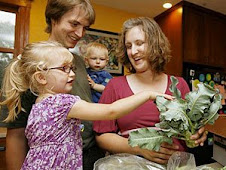I do have to say that the food was excellent at most stops and a few (brio, Octane, Irish Rose, Cru, Chocolat by Daniel, Kuma's, and even Capri) were very creative. Served along with the food at most locations were samples of Goose Island Beer. Although the ingredients don't come locally, at least the beer is brewed in Chicago. We had a great time and enjoyed getting out and venturing into local restaurants again.
Although we didn't eat out with great regularity before our local year, we did occasionally treat ourselves to a meal at a local downtown (or elsewhere in the area) restaurant. It was fun to be out and about again.
The kids stayed home with a babysitter but before I left them I fed them a local dinner which included homemade goat cheese, sugar snap peas, milk, and strawberries.
Speaking of Strawberries
I can't believe the year has passed and it's strawberry season again. I've been sampling strawberries from many of the vendors at area farmers' markets (I've hit three markets, a roadside stand, and Sheryl and Ray Murray's farm since we got back from vacation). Plus, we have our own strawberry patch that we planted last year. It's not prolific yet but we have a steady stream of a few handfuls a day. It's enough to make weeding worth it... we snack as we go. Between eating fresh and dehydrating (already thinking ahead to wintertime snacks!), we've gone through more than 16 quarts!
I do have to say, though, that our favorite strawberries have been from Murray's "Market" at their farm on Meridian Road, just north of Latham. They're only a few miles from our house and their strawberries have the most amazing taste!
 Add to it that theirs are the most reasonably priced and how can you go wrong? I'm sure they won't mind me passing along their phone number... 815-969-8104 (please tell them I gave you the number). Just call them to let them know how many quarts you want and when you want to pick them up and they'll pick them for you and have them waiting. As the growing season progresses they'll have much more... raspberries, onions, cucumbers,cabbage, tomatoes, the most amazing sweet corn, etc).
Add to it that theirs are the most reasonably priced and how can you go wrong? I'm sure they won't mind me passing along their phone number... 815-969-8104 (please tell them I gave you the number). Just call them to let them know how many quarts you want and when you want to pick them up and they'll pick them for you and have them waiting. As the growing season progresses they'll have much more... raspberries, onions, cucumbers,cabbage, tomatoes, the most amazing sweet corn, etc).Farmers' Markets and Recent Meals
I've definitely been having fun visiting my favorite markets again since our trip. I went to several before we left but it was early in the season and not all of the regular growers were there yet. Now that we're back and the weather is warming up the markets are getting into full-swing and it's like visiting with old friends for me. I really missed seeing some of these folks during the winter months! And I was surprised how many of them remembered me.
We bought some unusual and interesting herbs and tomato plants from Moonglow Organics (Heidi) and Juda Springs Farm (Dave and Cindy) at the North End Commons Market last Saturday and we learned about yet another new (to us) vegetable from Phil Bardell (who sells at North End and at Edgebrook; his farm is called Chestnut Hill and is in Freeport). The root vegetable is called scorzonera and it's a cousin to salsify (which Phil introduced us to last year when we bought a 5-gallon bucket for our winter food stores).
 Here is a site that has some nice photos of both roots and a recipe to boot. The recipe is not what I used for the scorzonera in this photo but it's a similar concept. This was Tuesday's dinner.
Here is a site that has some nice photos of both roots and a recipe to boot. The recipe is not what I used for the scorzonera in this photo but it's a similar concept. This was Tuesday's dinner.  As you can see, we're still going strong with yummy foods. The mixed greens in the salad were all harvested from our garden. The dressing was made with spring onions (purchased from Phil) and local yogurt (Bushel and Peck's) with some herbs and a little sherry. The grilled pork chops were from Kathy Spataro McGinty (Open Range Products - Pecatonica, processed by Eickman's in Seward). Kevin spiced them with some ground chipotle and garlic before we threw them on the grill. The Italian green beans were in our freezer (I didn't label that package but I think they were either either from Phil or from Pine Row Farm in Roscoe). What looks like French fries are actually the scorzonera, sauteed with a little butter and some salt and pepper. I didn't cook them long so they would retain some crunch (they were excellent raw as well). Another cool thing is that they can stay in the ground all winter. I think Phil said they had just dug them up for the market on Saturday! I really do appreciate all I'm learning from him and so many others who have taken the time to help me along the way.
As you can see, we're still going strong with yummy foods. The mixed greens in the salad were all harvested from our garden. The dressing was made with spring onions (purchased from Phil) and local yogurt (Bushel and Peck's) with some herbs and a little sherry. The grilled pork chops were from Kathy Spataro McGinty (Open Range Products - Pecatonica, processed by Eickman's in Seward). Kevin spiced them with some ground chipotle and garlic before we threw them on the grill. The Italian green beans were in our freezer (I didn't label that package but I think they were either either from Phil or from Pine Row Farm in Roscoe). What looks like French fries are actually the scorzonera, sauteed with a little butter and some salt and pepper. I didn't cook them long so they would retain some crunch (they were excellent raw as well). Another cool thing is that they can stay in the ground all winter. I think Phil said they had just dug them up for the market on Saturday! I really do appreciate all I'm learning from him and so many others who have taken the time to help me along the way.First CSA Box
We got our first veggie box of the season from Angelic Organics on Wednesday (thanks to our friend Constance who picked it up for us, along with our cow and goat milk and eggs!). This officially book-ends our year. We received our first box last year on June 19th. This week's box has great stuff in it: greens and lettuce, bok choi, radishes, and more.
So... "What's for dinner tomorrow night?" you ask. Local chicken (meat more than once this week, that's unusual) and local salad and veggies to be sure... but Kevin's parents bought us a Chilean wine and Kevin has asked me to bake cookies - the real stuff, with sugar and oats - for dessert. The truth is, we're looking forward to another great season (and year) of good local eats, even if we let a few non-local foodstuffs back into our kitchen... more on that this weekend.

















